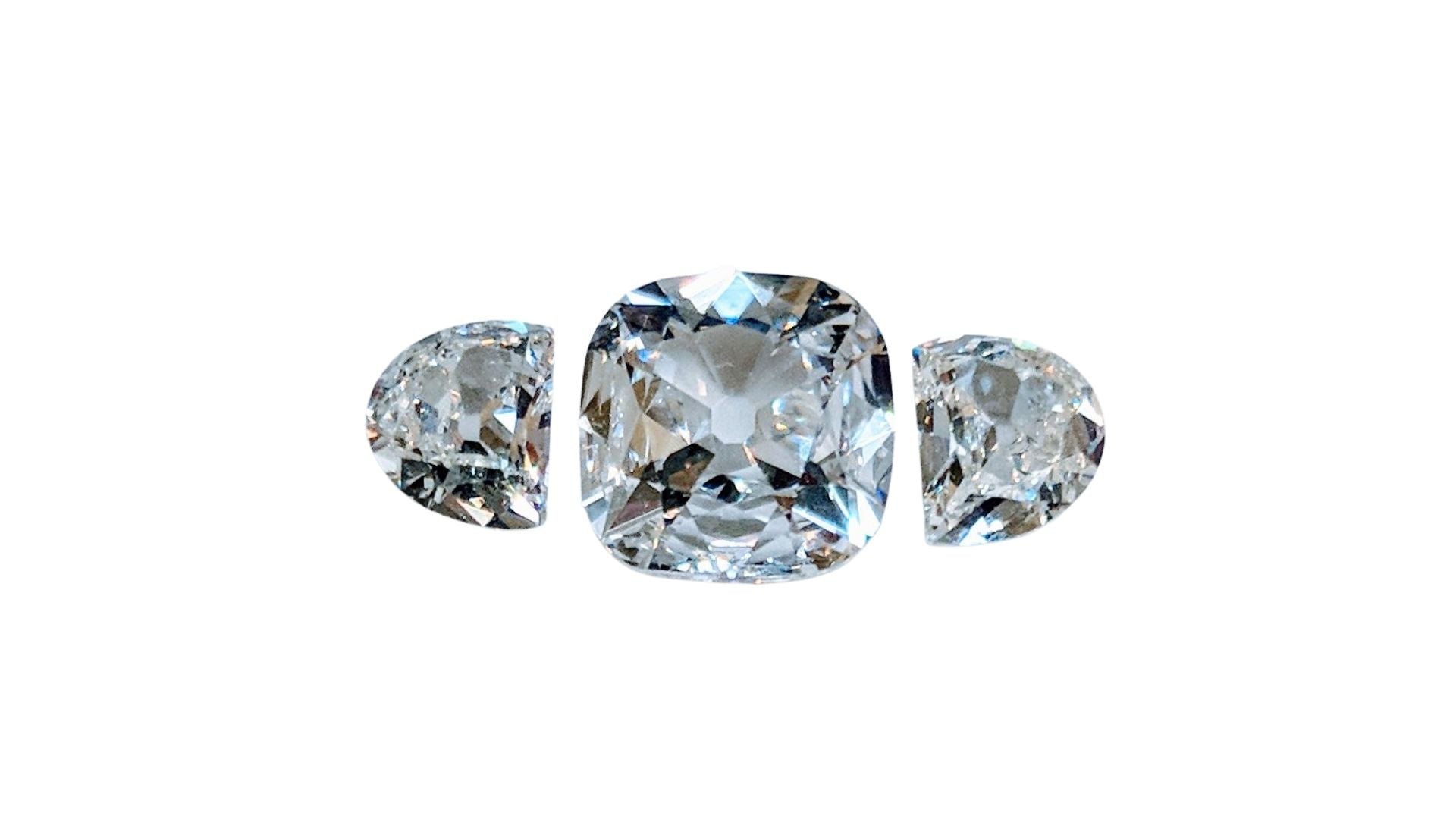BUYING YOUR FIRST DIAMOND
Buying your first piece of diamond jewelry can feel daunting. Besides the monetary and emotional investment going into it, the diamond industry jargon can be hard to understand. The first thing you want to do is inform yourself about what a diamond is and how to assess its value.
We’ve compiled a list of dos and don’ts while purchasing your first diamond to help ensure you have an enjoyable, stress free and well-informed experience. 
64Facets’ Old Mine Cushion Cut Center Diamond complemented by two half moon diamonds
What Not to Do
UNDERSTAND YOUR 4C'S
The most vital aspect to shopping for diamond jewelry is knowing and understanding how to assess the quality and thus the value of a diamond. The universal standards are covered in the 4C’s of diamonds, which stand for color, cut, carat, and clarity. These factors are integral to determining the quality of the diamond as well as its price point. View our article on the 4C’s for a detailed breakdown of the basics.
UNDERSTAND YOUR PREFERENCES
Your first diamond should reflect your preferences. Understanding the 4Cs along with different diamond shapes will help you make the right choice. If you’re considering to buy a piece of diamond jewelry for yourself, then this process becomes easier. Prioritize what you care about more: is it the size, color, clarity, shape, or design? Get yourself something that compliments your personality as opposed to following trends.
If your first diamond purchase happens to be a gift, then it is best to know the recipient’s personal preferences, especially if the jewelry in question is an engagement ring. We value individuality and personal taste and offer services to create bespoke engagement rings. Knowing the type or jewelry you want prior to the scouting process will allow you to narrow down your search.
SET A BUDGET
Your budget will determine the quality and kind of jewelry you end up purchasing. It is imperative to set a reasonable budget with a cut-off limit. This will help you select the perfect piece and help you prioritize.
CERTIFICATION IS KEY
One of the things to make sure is that your first diamond purchase carries a certificate of authenticity, which will allow you to have peace of mind by validating the quality of your diamond jewelry. At 64Facets we use GIA to assess the quality of our loose diamonds.
CONSIDER OPTICAL ILLUSIONS
Using thin, delicate bands can make your central diamond appear larger than it really is. Using other gemstones or even smaller diamonds as a halo around the central stone also makes a ring look grander. Such designs maximize value for money. The shape and cut of a diamond also has an impact on its visual appeal. Keep in mind that shallower cuts look bigger as they occupy more surface area and the carat weight is on the surface.
What to Do
BIGGER ISN’T ALWAYS BETTER
Don’t always go by size. A three-carat diamond with a low-quality cut, color or clarity will produce a sub-par final product and will be worth less than a two-carat expertly cut diamond with good color and clarity.
QUALITY OVER PRICE, ALWAYS
Ethically sourced quality diamonds come at a price. When shopping for diamonds online, if the listing looks too good to be true, it probably is. Your alarm bells should sound off at any seller trying to advertise their product substantially below the market rate.
DO YOUR RESEARCH: BRANDS, QUALITY AND ETHICS
If you’re going to indulge in a diamond, familiarizing yourself with the 4C’s as well as doing some background research on the brand you buy from is key to making an informed and empowered decision. Always check to make sure that the brand only works with trusted partners who procure their diamonds ethically. All 64Facets jewelry is created from conflict-free diamonds and we only work with responsible trade partners. Read more about our top tips for ensuring your diamonds are conflict free.
OVER EMPHASIS ON CLARITY AND COLOR
While a D flawless diamond is wonderful, you should choose a diamond that speaks to your personal style. If you care more about size, compromising a bit on the color and clarity will get you a lot more for your money. Naturally occurring diamonds are formed under immense pressure. Some microscopic inclusions are normal and do not always take away from the diamond’s beauty. In terms of clarity, we recommend not going for diamonds rated below SI1. As long as the diamond appears clear to the naked eye, you should be okay. Similarly, while whiter diamonds (rated D-G) are the most sought after, diamonds with a mildly yellow tint also have their own unique glow.
FLUORESCENCE ISN’T ALWAYS BAD
A diamond’s fluorescence i.e. its ability to emit a soft blue glow under ultraviolet (UV) light has an impact on its color. Not all diamonds have this quality. If diamonds with a Clear grading (D-F) are fluorescent, they appear more milky or hazy and thus are priced down. However, it is interesting to note that if you are opting for a lower quality stone rated Near Colorless to Faint (I-M) this bluish tinge cancels out yellow tones in the stone, making it look brighter, shinier and therefore more valuable.
At the end of the day, there is no code to purchasing the “perfect diamond”. Beauty is relative, and this applies to diamonds as well. As long as you stay true to your priorities and know your diamond basics, you will end up choosing the right piece for yourself and your loved ones. Happy shopping!


Leave a comment